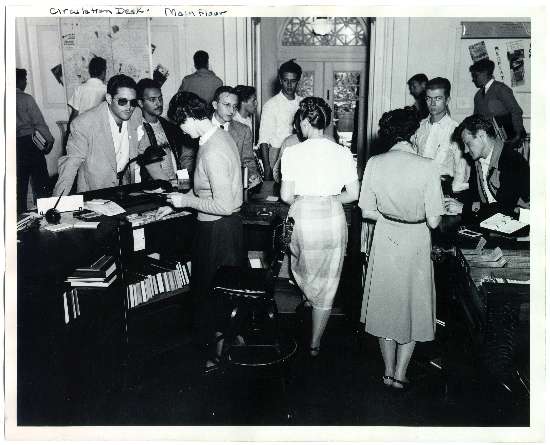 |
GTVA-223-K
Location:
T171 .G42 G49x GTVA-223-K
Title: Date:
[Carnegie Library Circulation Desk]
Unknown
Content:
Writing on front of photo - upper left corner, black ink: Circulation Desk, main floor. Writing on back:
#1220, Library, Carnegie Building. Sticker on back. Moisture wrinkling. Damage on negative.
History:
One of Matheson's strong interests and of great importance to the School in its quest to be an academic
institution of merit was the development of a good library. While Chairman of the English Department,
Matheson had begun a library first housed in his office and then on the third floor of the Academic
Building. The Annual Announcement of 1902-1903 described the library on the third floor of the Academic
Building as having a handsomely-furnished and well-equipped reading room equipped with some forty of the
leading papers and periodicals had been established in connection with the library.
Matheson wrote to Andrew Carnegie and persuaded him to fund a library at the Georgia School of Technology.
Carnegie donated $20,000 to build the library, provided the school agrees to furnish $2,000 a year to
sustain the library and employ trained help. The architectural firm of Morgan and Dillon was hired to
design the library. President Matheson was enthusiastic about the proposed design, noting every foot of
available space will be used and the building will be flooded with light. The Library was designed to hold
6,000 to 8,000 volumes in the library proper, with a stack room of 30,000 volumes. The Carnegie Library
opened for business September 1907.
From Warren Drury's thesis: Architecturally, the Carnegie Library is the most exciting and ornate building
designed for the campus during this period. Neo-classic in design, it maintains a simple orderlyness in
its forms. The building is composed of a single compact block articulated with an entry portico. The
ornate entrance block has canted Ionic columns in antis. A decorative parapet panel with balanced blank
shields surrounding the school name and capped by the Tech shield surrounding by decorative limestone work
complete this block. The axis of symmetry is reinforced by a vertical flag pole. Between the columns in
antis is the arched entrance.
Also visible in this photograph is the Academic
Building, described in the Georgia Tech Announcements for the period as "a splendid edifice of brick,
trimmed with granite and terra cotta, slate roof. It has a one hundred and thirty foot front, is one
hundred and twenty deep, and is four stories high above the basement story. It contains ample
accomodations in halls, offices, apparatus rooms, recitations and lecture rooms, free hand and mechanical
e itectural firm of Bruce
1959, when it became exclusively administration and was renamed the Administration Building.